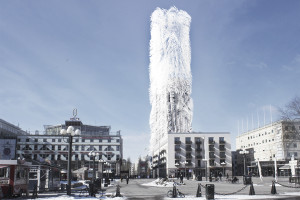by Jonathan Fincher, Gizmag, May 23, 2013

Image: Belatchew Arkitekter
Source: www.belatchew.com
Despite being the most common renewable energy technologies, solar panels and wind turbines still have their shortcomings. Particularly when it comes to the urban environment. Lack of space and concerns about noise are just two problems with integrating them into city settings in an unobtrusive way. That’s why Belatchew Arkitekter wants to try a different approach with its Strawscraper concept, which proposes transforming the Söder Torn building in Stockholm into an urban wind farm by covering it in piezoelectric fibers.
When the Söder Torn building was originally proposed, its design called for 40 stories to be built, but construction was halted in 1997 at only 25 floors. Belatchew Labs, a studio within Belatchew Arkitekter, wants to revisit the taller design, providing space for extra residences while also converting the new sections into an urban wind farm.
The group’s concept involves covering most of the building with thin straws consisting of flexible polymers and a core of piezoelectric materials. According the designers, as the straws sway in the wind the mechanical stress would generate an electric charge, which could then be used to provide power to the building itself along with the surrounding area.
The company says this technology could turn any building, whether old or new, into its own energy source, while producing less noise and requiring lower wind speeds than a typical wind turbine. The flowing fibers could also add to the buildings aesthetics, giving the appearance of rippling waves or grass fields, especially with the addition of colored lighting.
The design could be likened to a trimmed down version of the windstalk concept that is located on the exterior of a building rather than on the ground. Although current piezoelectric generators are only able to generate small amounts of power, there is work being done to improve their capabilities. These include using nanomaterials and giving them the ability to work with a wider range of frequencies.
However, even if the technology were sufficiently advanced to the point that piezoelectric power becomes a feasible large-scale energy source, employing it on a building that resembles an enormous sheepdog might be a hard sell.